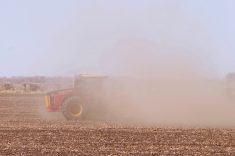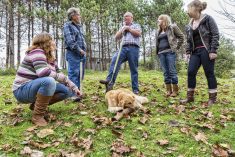There’s no shortage of risks when you grow crops for a living. As a farmer, you’re accustomed to coping with weather extremes, weed resistance, disease outbreaks, insect infestations and other threats to your hard-earned yields. But are you doing enough to manage other risks, like safety hazards on your farm or essential equipment breakdowns?
Farm risk experts and financial advisors for the Co-operators Group Perri-Rae Boell and Sherry Watty say there are steps farmers can take to manage their financial risks, such as ensuring they have adequate insurance coverage for equipment breakdowns as well as unforeseen business interruptions. Another risk-reducing measure is to inspect farm buildings and equipment to identify threats to farmworker health and safety, they say.
Both Boell and Watty spoke to farmers last November at the Advancing Women in Agriculture virtual conference.
“Farms can be dangerous places with many hazards that can escape one’s notice. The first step in preventing injuries is to become aware of the potential hazards,” says Boell, owner of Perri-Rae Boell and Associates in Pembroke, Ont.
“Some of the items we look at when we’re doing physical inspections are fuel storage tanks. What is their condition? Is there corrosion on the tank? Does it have vehicular protection around it? Is the vegetation cleared away? Does it have a no smoking sign on or near it?”

Outdoor wood furnaces also require close attention. “Have they been professionally installed, or have they been installed by the owner? Have they been inspected by a professional? How close are they to buildings and wood piles, and is the vegetation cleared around it? Does the unit have a spark arrest cap on it? Those are a few things that we look at for outdoor wood furnaces,” notes Boell.
Fires on farms can also be caused by faulty wiring, electrical overloading, worn insulation and poor maintenance. “Taking care of your electrical system can prolong its life and reduce the risk of personal injury, property damage and fires,” says Boell.
She offers up several tips for reducing fire risks, including:
Read Also

Cancer agency reclassifies another herbicide ‘probably carcinogenic’
The WHO’s cancer research agency has now put atrazine, a herbicide well known to corn growers, in the same potential-hazard category where the agency put glyphosate.
- Have appropriate electrical fixtures and keep them in proper condition.
- Update and maintain electrical inspections by professionals.
- Identify, control or isolate all sources of ignition on the farm.
- Ensure grain bins are far away from any electrical hazards.
- Mount multi-purpose dry chemical fire extinguishers on tractors and farm implements.
Something else for farmers to consider is physically demanding work that involves moving heavy loads, says Boell. “Do they have employees that are working alone, lifting heavy loads, or working in isolated areas or extreme weather?”
Once hazards have been identified, the onus is on farmers to make changes that reduce or eliminate them to minimize risks to workers and to protect farm owners from potential liability claims, she adds.
“Changes can include providing better or standardized training for workers on the farm, putting up caution or no trespassing signs, installing fire extinguishers, posting no smoking signs, posting fire emergency numbers near telephones, and developing and posting an emergency fire plan.”
If there are any children on the farm, it’s imperative to keep them clear of enclosed spaces, wells, manure pits and silos, Boell notes. She said one solution is to create a designated, fenced-in area for kids that is away from dangerous work areas.
Furthermore, Boell has other suggestions on how farmers can protect themselves, their families and the people who work for them from harm, including:
- Keep all hazardous materials stored safely.
- Keep all exits clear and ensure hallways, stairs and floors are uncluttered and in good repair.
- Ensure there is adequate light and ventilation for farm workers.
- Provide adequate visibility for vehicles and equipment entering and leaving the farm property.
- Identify and post all overhead power lines where tall equipment like grain augers can operate.
Equipment breakdown insurance
Farms today, no matter how large or small they are, rely on multiple pieces of machinery and technology to ensure they are efficient and profitable. Breakdown insurance is a way to keep the farm business running, even if the equipment isn’t.
Boell says property insurance will cover buildings and contents but typically doesn’t include coverage for loss or damage caused by pressure systems and mechanical and electrical equipment on a farm, which can include air conditioning and refrigeration units, heating systems, boilers and electronics.
Boell urges farmers to check with their insurance agents about equipment breakdown coverage to determine if it’s included with their farm insurance as well as to gain a good understanding of exactly what’s covered. If equipment breakdown coverage isn’t part of the policy, she strongly recommends farmers get it.
“Equipment breakdown insurance covers you for property damage resulting from the sudden accidental breakdown of insured equipment that is not automatically covered by a standard commercial farm insurance policy,” she says.
“When (something) breaks down, ruptures or cracks, with equipment breakdown insurance, you can rely on coverage for costly repairs and keep your business running at the same time.”
Losses incurred by farm equipment breakdowns can be direct, such as physical damage to the equipment and insured property, she notes, but they can also be indirect — spoilage is one example.
Business interruption insurance
There may be times when producers have no choice but to shut down their farm operations temporarily before they can get things back up and running again. When that happens, agricultural business interruption insurance provides farmers with financial compensation for lost income and other things like ongoing operating expenses.
In Watty’s view, having business interruption insurance for your farm is by far one of the most vital aspects of managing financial risk.

“It’s such an important feature, and I always feel that when I sit down and speak with my farmers, it’s most often overlooked,” says Watty, who owns Watty Insurance Services in Abbotsford, B.C.
Watty says what she recommends to farmers is a type of business interruption insurance called Actual Loss Sustained (ALS)
As the name implies, ALS coverage insures farmers for the actual financial loss on the farm for an insurable interruption of business. Generally, coverage ends when the farm operation and earnings return to the same condition they were in before the loss or until a certain time period has elapsed.
Watty says you can never be certain how long a business interruption may last, which is why she urges farmers to make sure they’re covered for at least 24 months.
“The farmer has to really consider how long it would take to get back into operation,” she says, adding that because of ongoing challenges caused by supply chain disruptions, 36 months is even better.
“It’s really, really important to try to extend the business interruption (period) for as long as possible,” says Watty.
















